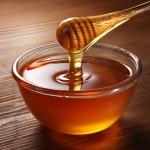Get Ready for National Honey Month
This entry was posted on September 08, 2015 .

Revamp Jar Labels in Honor of National Honey Month
September is a banner month for a number of different industries and causes. According to Holiday Insights, the ninth month of the year is a time to safeguard the youngest members of the population (Baby Safety Month), cheer on those who are growing up way too fast (Little League Month), have some fun on the dance floor (International Square Dancing Month) and become better people (Self Improvement Month). It's also National Honey Month, which is a great thing for honey-makers to showcase on their jar labels.
What's the Buzz About Honey? Offer Insight Using Food Labels
Beyond the (admittedly very cool) fact that honey comes from nectar and is produced by bees, most people don't know a lot about this humectant, so why not include some information about the product on food labels?
First question: What's a humectant? As the National Honey Board's Honey.com website explained, humectants are compounds that not only minimize moisture loss but actively attract moisture as well. To put it another way, honey isn't only great for sweetening tea or spreading on toast - it's also a powerful beauty ingredient that makes skin glow. What's more, its soothing properties make it an effective remedy for coughs and sore throats.
Use Honey Jar Labels to Highlight Product Varietals
Did you know there are more than 300 varieties of honey available in the United States? Honey-makers that offer multiple types should be sure to indicate which is which on their honey jar labels. According to the National Honey Board, you can tell some kinds apart from their color: Light-colored honeys tend to have a mild flavor, while their darker equivalents have a stronger taste. The varietals are made using nectar sourced from a range of flowers and plants, including avocado blossoms, eucalyptus, sage and tulip poplar. Many have different applications - for instance, Sourwood honey makes a mean glaze, while you can often find orange blossom honey in baked goods like cookies and cakes.
Warning: Crystallization! Include Storage Instructions on Honey Labels
Honey is best stored at room temperature. As the National Honey Board explained, putting it in the fridge speeds up the crystallization process. While crystallization doesn't lead to spoilage or indicate low quality, nobody wants to eat crunchy honey. Consumers can avoid crystallization by storing honey in a pantry or simply leaving it out on the countertop, but they may not necessarily know that they need to do so, which is where honey labels come in. As well as detailing information about the product's manufacturer, its varietal, its nutritional benefits and the like, labels on containers of honey should also include storage instructions and advice about what to do if the honey crystallizes (heat up the jar until the crystals dissolve). Crystallization is a harmless, reversible process, but consumers who don't know what it is may end up throwing away perfectly good honey - and denying themselves the associated health and beauty benefits in the process.
Request your FREE instant quote today.

 Custom Labels
Custom Labels  Custom Beverage Labels
Custom Beverage Labels  Custom Lip Balm Labels
Custom Lip Balm Labels  Custom Warning & Safety Labels
Custom Warning & Safety Labels  Perfume Bottle Labels
Perfume Bottle Labels  Bumper Stickers
Bumper Stickers  Custom Prop 65 Warning Labels
Custom Prop 65 Warning Labels  Custom Stickers
Custom Stickers